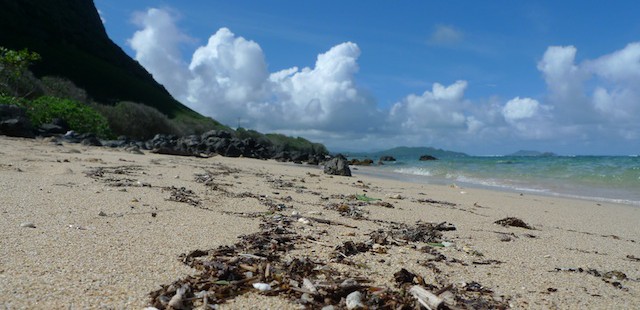— Report translated from German —
According to a recent study, 270,000 tons of plastic waste are floating in the world’s oceans. That sounds like a lot, but the annual production of plastic is over a thousand times higher. So scientists are starting to wonder: Has the inventory of plastic in the oceans just scratched the surface? New samples from the bottom of the deep sea might provide an answer.

For Richard Thompson, the small particles are the most worrisome. A marine biologist at the University of Plymouth in the UK, Thompson has researched the spread of man-made materials into marine ecosystems for the past twenty years. He has found plastic particles in the sea water and in the sand of beaches around the world, and was one of the first to focus on microplastics – the tiny pieces.
Sound bite: Richard Thompson
“One of the puzzles that challenged people working on debris in the ocean, particularly plastic debris, is that if you look at data over time – from beach cleaning activities, or from monitoring activities at the sea surface – you don’t see any temporal trends, you don’t see any change over time. And yet we know that plastics are very persistent and durable, that they’ll persist in the ocean potentially for hundreds of years, and our production of plastics has increased exponentially, so you’d expect to see a dramatic increase in the quantities of marine litter.… Where that created a query for me is to try to work out, well, where is actually all the plastic going?”
Scientists like Thompson have long suspected that some of it sinks to the bottom of the ocean. But taking samples thousands of meters deep is technically challenging and very costly. Thompson could not find funding for such an expensive study. But then researchers at the University of Barcelona and the Natural History Museum in London contacted him. When searching for life on the bottom of the sea, they had found strange fibers in their probes of ocean mud. Even Richard Thompson was surprised by the result of the following analysis:
Sound bite: Richard Thompson
“Indeed, what we found was that the numbers were really quite substantial, that the number of small particles that we were finding in deep sea sediments – if you compare it volume per volume: a volume of the mud from the seabed in the deep sea with the same volume of water taken from the surface of the oceans – even in some of the most contaminated surface water gyres, we’re finding substantially more on the seabed in the deep sea. So it’s very clear that the deep sea is a place of accumulation for this plastic.”
The concentration of microplastics in the sediment might be ten thousand times that of the concentration in large oceanic gyres, conclude the researchers in their publication in Open Science. At the surface, on the other hand, the trash appears to be a welcoming home for some of the sea creatures. This could answer the question of how the light plastics – which usually swim on top – could have reached depths of up to 3,500 meters.
Sound bite: Richard Thompson
“Most polymers are naturally buoyant when they enter sea water … they are all relatively low density; they’re not gonna sink rapidly. But once an item enters the sea … it will become colonized by microorganisms and by larger organisms; marine life will rapidly colonize it, and that can cause the overall density to change … effectively, what we’d call the fouling load can cause a buoyant piece of plastic to sink down.”
Whether the researchers looked at samples from the Mediterranean, the North Atlantic, or the Indian Ocean, they found microscopically small fibers in all of them. More than half of the fibers were made from rayon, a semi-synthetic fiber used in diapers for babies and cigarette filters. The second-most frequent material was polyester. After these coincidental findings, Richard Thompson would like to research the whereabouts of trash on the ocean floor in more detail.
Sound bite: Richard Thompson
“What we’re curious to do is to establish a kind of, a mass balance almost: Where does debris go to? It’s only when we can piece that together and when we understand the hot spots – if you like, the places of high accumulation – we need to understand where they are because that will affect the impact, what harm or not this debris causes. The greater the concentration of this debris, the more likely it is to harm marine life.”
The ocean floor is only one of the places where substantial amounts of plastic could be found. There is another, intermediate “storage unit,” which could hide it from researchers’ view: the stomachs of whales, fish, and many other forms of marine life, which are confusing trash with food and carrying it through the oceans and into the food chain.
Presenter: Ralf Krauter
Heaps of plastic trash hide in the deep sea floor: this was Anja Krieger on the findings of a new study.
—
Credits + Links
Broadcast December 22, 2014,
on Deutschlandfunk “Forschung aktuell”
Length: 4:41 minutes
Report: Anja Krieger
Host and editor at Deutschlandfunk: Ralf Krauter
MP3 (German)
Text (German)
